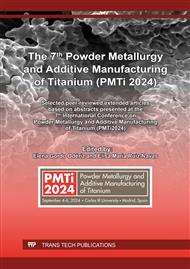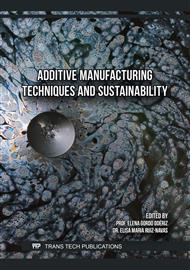[1]
H. Cheng et al., "Improving the performance of titanium bipolar plate in proton exchange membrane water electrolysis environment by nitrogen-chromium composite cathode plasma electrolytic deposition," Int J Hydrogen Energy, vol. 48, no. 98, pp.38557-38568 Jul. (2023)
DOI: 10.1016/j.ijhydene.2023.06.177
Google Scholar
[2]
A.N. Mancino, C. Menale, F. Vellucci, M. Pasquali, and R. Bubbico, "PEM Fuel Cell Applications in Road Transport," Energies, vol. 16, no. 17. Multidisciplinary Digital Publishing Institute (MDPI), Sep. 01, (2023)
DOI: 10.3390/en16176129
Google Scholar
[3]
H. Ito, T. Maeda, A. Nakano, A. Kato, and T. Yoshida, "Influence of pore structural properties of current collectors on the performance of proton exchange membrane electrolyzer," Electrochim Acta, vol. 100, p.242–248, Jun. (2013)
DOI: 10.1016/j.electacta.2012.05.068
Google Scholar
[4]
S. Mekhilef, R. Saidur and A. Safari, "Comparative study of different fuel cell technologies", Renewable and Sustainable Energy Reviews, vol 16, pp.981-989, Oct. (2012)
DOI: 10.1016/j.rser.2011.09.020
Google Scholar
[5]
C. Qiu, Z. Xu, F-Y. Chen and H. Wang, "Anode Engineering for Proton Exchange Membrane Water Electrolyzers", ACS Catalysis, vol. 14, pp.921-954, Jan. (2024)
DOI: 10.1021/acscatal.3c05162
Google Scholar
[6]
A. Tang, L. Crisci, L. Bonville and J. Jankovic, "An overview of bipolar plates in proton exchange membrane fuel cells", Journal of renewable and sustainable energy, vol. 13, 022701, (2021)
DOI: 10.1063/5.0031447
Google Scholar
[7]
Z. Xu, D. Qiu, P. Yi, L. Peng and X. Lai, "Towards mass applications: A review on the challenges and developments in metallic bipolar plates for PEMFC", Progress in natural science, vol. 30, n.o 6, pp.815-824, (2020)
DOI: 10.1016/j.pnsc.2020.10.015
Google Scholar
[8]
K. Karacan, S. Celik, S. Toros, M. Alkan, y U. Aydin, "Investigation of formability of metallic bipolar plates via stamping for light-weight PEM fuel cells", International journal of hydrogen energy, vol. 45, n.o 60, pp.35149-35161, (2020)
DOI: 10.1016/j.ijhydene.2020.01.251
Google Scholar
[9]
S. Porstmann, T. Wannemacher, W-G. Drossel, "A comprehensive comparison of state-of-the-art manufacturing methods for fuel cell bipolar plates including anticipated future industry trends", Journal of Manufacturing Processes, vol. 60, pp.366-383, Oct. (2020)
DOI: 10.1016/j.jmapro.2020.10.041
Google Scholar
[10]
Z. Ren, D. Zhang, and Z. Wang, "Stacks with TiN/titanium as the bipolar plate for PEMFCs," Energy, vol. 48, no. 1, p.577–581, (2012)
DOI: 10.1016/j.energy.2012.10.020
Google Scholar
[11]
B. Avasarala and P. Haldar, "Electrochemical oxidation behavior of titanium nitride based elecrocatalysts under PEM fuel cell conditions", Electrochimica Acta, vol. 55, pp.9024-9034, Aug. (2010)
DOI: 10.1016/j.electacta.2010.08.035
Google Scholar
[12]
T.J. Toops et. al., "Evaluation of nitrided titanium separator plates for proton exchange membrane electrolyzer cells", Journal of Power Sources, vol. 272, pp.954-960, Sep. (2014)
DOI: 10.1016/j.jpowsour.2014.09.016
Google Scholar
[13]
D. Zhang et. al., "TiN-coated titanium as the bipolar plates for PEMFC by multi-arc ion plating", International journal of hydrogen energy, vol 36, pp.9155-9161, Apr. (2011)
DOI: 10.1016/j.ijhydene.2011.04.123
Google Scholar
[14]
A. P. Manso, F. F. Marzo, J. Barranco, X. Garikano, and M. Garmendia Mujika, "Influence of geometric parameters of the flow fields on the performance of a PEM fuel cell. A review," International Journal of Hydrogen Energy, vol. 37, no. 20. Elsevier Ltd, p.15256–15287, (2012)
DOI: 10.1016/j.ijhydene.2012.07.076
Google Scholar
[15]
A. Baroutaji, J. G. Carton, J. Stokes, and A. G. Olabi, "Application of Open Pore Cellular Foam for air breathing PEM fuel cell," Int J Hydrogen Energy, vol. 42, no. 40, p.25630–25638, Oct. (2017)
DOI: 10.1016/j.ijhydene.2017.05.114
Google Scholar
[16]
J. K. Lee et al., "Spatially graded porous transport layers for gas evolving electrochemical energy conversion: High performance polymer electrolyte membrane electrolyzers," Energy Convers Manag, vol. 226, Dec. (2020)
DOI: 10.1016/j.enconman.2020.113545
Google Scholar
[17]
H. Wang, M. A. Sweikart, and J. A. Turner, "Stainless steel as bipolar plate material for polymer electrolyte membrane fuel cells," J Power Sources, vol. 115, no. 2, p.243–251, Apr. (2003)
DOI: 10.1016/s0378-7753(03)00023-5
Google Scholar



